In addition to these more commonly known risk factors, many people don’t realize that they’re in greater danger of developing sleep apnoea, or OSA, if they already suffer from other common diseases.
“Seven in 10 Type 2 diabetics and 30 to 40% of adults with hypertension also have obstructive sleep apnoea,” said Dr. Badr, who is the President of the world famous Academy of Sleep Medicine. “As a result, patients with these conditions should pay close attention for potential symptoms and then seek necessary treatment – immediately.”
Sleep Apnoea sufferer using CPAP equipment at night
Watch for symptoms
While the symptom most commonly associated with sleep apnoea is snoring, not everyone who snores has the disease. However, when snoring is paired with choking, gasping or pauses in breathing during sleep, it’s a more likely indicator of sleep apnoea.
Sleep apnoea symptoms also may appear during the daytime and include morning headaches, excessive sleepiness, trouble concentrating, memory or learning problems and general moodiness, irritability or depression.
Sleep apnoea can make you wake up in the morning feeling tired, even though you believe you’ve had a full night of sleep. During the day, you may feel incredibly fatigued because you’re actually waking up numerous times throughout the night and your body isn’t getting the rest it needs.
If you suspect that you have the risk factors and symptoms of sleep apnoea, it’s important that to be evaluated by your physician right away because if left untreated, sleep apnoea may have a serious impact on your overall health, even increasing your risk of death. Your GP may refer you to a specialist in Sleep Medicine or a Sleep Centre for tests.
The sleep medicine physician will have the training and expertise to diagnose your condition. He or she will conduct a thorough physical examination and sleep evaluation, asking questions like whether or not symptoms began when you gained weight or stopped exercising — and whether your partner or roommate has complained that you snore or make choking noises in your sleep. If the sleep physician determines that you are at risk for obstructive sleep apnoea, then you will be scheduled for a full sleep study. Objective sleep testing will provide the data that will enable the sleep physician to make an accurate diagnosis.
Once diagnosed, the recommended treatment for sleep apnoea is usually CPAP – continuous positive airway pressure therapy, which provides a steady stream of air through a mask to gently keep your airway open throughout the night — making it easier to breathe. In patients with moderate or severe sleep apnoea, it’s estimated that CPAP therapy reduces the 10-year risk of heart attack by 49% and stroke by 31%.
The following statements from the British Lung Foundation summarise it well.
Caroline Stevens, Interim Chief Operating Officer at the BLF, said:
“The BLF’s OSA charter reflects the need for earlier diagnosis, better access to treatment and increased awareness – both amongst the wider public and medical community. The impact of OSA on health and lifestyle means these recommendations not only have the potential to save lives, but to make considerable savings to the NHS at a time of great financial pressure”.
Dr Keith Prowse, BLF Honorary Medical Adviser said:
“This is not a niche problem – OSA is estimated to affect up to 4% of men and 2% of women, and with the current low levels of awareness, many are likely to be undiagnosed. Left untreated, it can also significantly affect the quality of life of those living with the condition, and can lead to a range of health problems, such as stroke and heart disease.
“The frustrating thing is that effective treatments are available, but because public awareness and diagnosis rates remain so low, there could be many thousands of people unnecessarily living with the health risks and impaired quality of life OSA can cause. Improved awareness and services, of the kind called for in the BLF’s charter, are therefore essential if we are to tackle the considerable burden OSA is placing on the health of the nation.”
What more incentive could you need to check it out?
Biography
John Redfern worked for 15 years at leading London Advertising agencies writing on many international products and markets during that time, before moving into a consultancy role, where he has gained long experience of writing on important matters of personal health. John has had in-depth involvement in a broad spectrum of subjects in this area, covering all possible age groups.
Through his work as a consultant to No Snore Zone, John has acquired an in-depth knowledge of snoring and sleep apnoea, and the many serious health problems with which they are so closely associated.
In addition, he has spent time developing projects for the British National Health Service, some major educational groups and authorities, and various voluntary organizations and manufacturers whose aim is to focus on family health, fitness and well-being.


OSA could cause heart related problems.